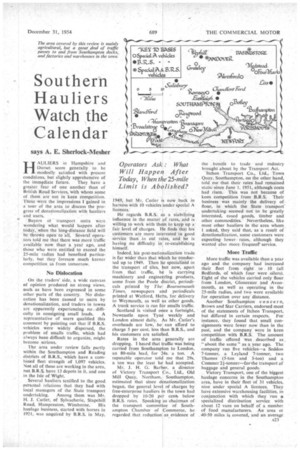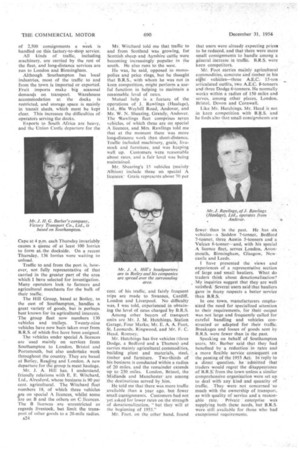Southern Hauliers Watch the Calendar
Page 25

Page 26

If you've noticed an error in this article please click here to report it so we can fix it.
says A. E. Sherlock-Mesher I4'iii.1;11:Rssee„T gtmrapislyhireto aZI
Operators Ask : What Will Happen After Today, When the 25-mile Limit is Abolished?
modestly satisfied with present conditions, but slightly apprehensive of the immediate future. They have a greater fear of one another than of British Road Services, with whom some of them are not in keen competition. These were the impressions I gained in a tour of the area to discuss the progress of denationalization with hauliers and users.
Buyers of transport units were wondering what would happen after today, when the long-distance field will he thrown open to all. Several operators told me that there was more traffic available now than a year ago, and those who were entitled to exceed the 25-mile radius had benefited particulady, but they foresaw much keener competition as from tomorrow.
No Dislocation On the traders' side, a wide canvass of opinion produced no strong views, such as have been expressed in some other -parts of the country. No dislocation has been caused to users by denationalization, and traders in towns are apparently experiencing no.• diffi
culty in consigning small loads. A representative of users qualified this comment by pointing out that if B.R.S. vehicles were widely dispersed, the problem of smalls traffic, which had always been difficult to organize, might become serious.
The area under review falls partly within the Southampton and Reading districts of B.R.S., which have a combined fleet strength of 1,097 vehicles. Not all of these are working in the area, hut B.R.S. have 13 depots in it. and one in the Isle of Wight.
Several hauliers testified to the good personal relations that they had with local managers of the State transport undertaking. Among them was Mr. H. J. Cutler, of Sylvacherie, Stapehill Road, Hampreston, Wimborne. His haulage business, started with horses in 1921, was acquired by B.R.S. in May, 1949, but Mr. Cutler is now back in harness with 10 vehicles 'under special A licences: He regards B.R.S. as a stabilizing influence in the matter of rates, and is willing to work With them to keep up a' fair level of charges. He finds that his customers are more interested in good service than in cut rates, and he is having no difficulty in re-establishing himself,
Indeed, his post-nationalization trade is far wider than that which he conducted up to 1949. Then he specialized in the transport of tiles, but now, apart from that traffic, he is carrying machinery and engineering products, some from the Poole district, periodicals printed by The Bournemouth Times, newspapers and periodicals printed at Watford, Hens, for delivery to Weymouth, as well as other goods. A trunk service is run for smalls traffic.
Scotland is visited once a fortnight, Newcastle upon Tyne weekly and London almost daily. As Mr. Cutler's, overheads arc low, he can afford to charge 5 per cent. less than B.R.S., and his customers are satisfied.
Rates in the area generally arc dropping. I heard that traffic was being carried from Southampton to London, an 80-mile lead, for 24s. a ton. A reputable operator told me that 29s. a ton was the least he had accepted.
Mr. I. H. G. Barber, a director of Victory Transport Co., Ltd., Old Mill Quay. Northam, Southampton, estimated that since denationalization began, the general level of charges by free-enterprise hauliers in the town had dropped by 10-20 per cents below B.R.S. rates. Speaking as chairman of the transport committee of Southampton Chamber of Commerce, he regarded that reduction as evidence of
the benefit to trade and industry brought about by the Transport Act. 'lichen Transport Co., Ltd., Town Quay, Southampton, on the other hand, told me that their rates had remained static since June 1, 1951, although costs had risen. This was not because of keen competition from B.R.S. Their business was mainly the delivery of flour, in which the State transport. undertaking seemed not to be greatly interested, cased goods, timber and other commodities. Nevertheless, like most other hauliers in the area whom
asked, they said that, as a result of denationalization, some customers were expecting lower rates, although they wanted also more frequent service.
More Traffic
More traffic was available than a year ago and the company had increased their fleet from eight to 10 (all Bedfords, of which four were oilers). Eight of the vehicles carried only flour from London, Gloucester and Avonmouth, as well as operating in the 25-mile radius, and two were available for operation over any distance.
Another Southampton concer n, Brown and Star Carriers, endorsed most of the statements of Itchen Transport, hut differed in certain respects. For instance, they found that small consignments were fewer now than in the past, and the company were in keen competition with B.R.S. The amount of traffic offered was described as, "about the same" as a year ago. The company run five vehicles—a Seddon 7-tonner, a Leyland 7-tonner, two Thames' (5-ton and 3-ton) and a Commer 24-tonner—for-the transport of baggage and general goods.
Victory Transport, one of the biggest haulage concerns in the Southampton area, have in their fleet of 31 vehicles, nine under special A licences, They have extensive warehousing facilities, in conjunction with which they run a specialized distribution service with about 12 vans on behalf of a number of food manufacturers. An area ol 40-50 miles is covered, and an average of 2,500 consignments a week is handled on this factory-to-shop service.
All kinds of traffic, including machinery, are carried by the rest of the fleet, and long-distance services are run to London and Birmingham.
Although Southampton has local industries, most of the traffic to and from the town is imported or exported. Fruit imports make big seasonal demands on transport. Warehouse accommodation at the docks is restricted, and storage space is mainly in transit sheds, which must be kept dear. This increases the difficulties of operators serving the docks.
Exports to South Africa are heavy,• and the Union Castle departure for the
Cape at 4 p.m. each Thursday invariably causes a queue of at least 100 lorries to form at. the dockside. On a recent Thursday, 136 lorries were waiting to unload.
Traffic to and from the port is, however, not fully representative of that carried in the greater part of the area which I have selected for investigation. Many operators look to farmers and agricultural merchants for the bulk of their traffic.
The Hill Group, based at Batley, to the east of Southampton, handles a great variety of goods, but is perhaps hest.known for its agricultural interests. The group fleet now numbers 130 vehicles and trailers, Twenty-nine vehicles have now been taken over from B.R.S. of which five have been assigned.
The vehicles under special A licences are used mainly on services from Southampton to London. Bristol and Portsmouth, but also undertake work throughout the country. They arc based at Botley, Reading and London. A new departure for the group is meat haulage.
Mr. J. A. Hill has. I understand, friendly relations with E. E. Witchard, Ltd., Alresford, whose business is 90 per cent. agricultural. The Witchard fleet numbers 18, of which three vehicles tre on special A licences, whilst some are on B and the others on C licences. The B licences are unrestricted as regards livestock, but limit the transport of other goods to a 20-mile radius.
A24 Mr. Witchard told me that traffic to and from Scotland was. growing, for Scottish sheep and Ayrshire cattle were becoMing increasingly popular in the south. He also runs to the west.
He was, he said, opposed to monopolies and price rings, but he thought that B.R.S., with whom he was not in keen competition, might perform a useful function in helping to Maintain a reasonable. level of rates.
Mutual help is a feature of the operations of . J. Rawlings (Haulage), Ltd., 80a Weyhill Road, Andover, and Mr. W. N. Shearing, GrateIy, Andover. The 'Rawlings fleet comprises seven vehicles, of which three are on special A licences, and Mrs. Rawlings told me that at the moment there was more long-distance work than short-distance. Trafficincluded machinery, grain, livestock and furniture, and was keeping well up. Customers Were reasonable about rates, and a fair level was being maintained, Mr. Shearing's 15 vehicles (mainly Albion) include three on special A licences: Grain represents about 70 per cent. of his traffic, and fairly frequent trips are made to Swansea, Cardiff, London and Liverpool. No difficulty was, I was told, experienced in obtaining the level of rates charged by B.R.S.
Among other buyers of transport units are Mr. J. M. Hutchings, Station Garage, Four Marks; Mr. E. A. A. Foot, St. Leonards, Ringwood, and Mr. F. C. Head, Romsey.
Mr. Hutchings has five vehicles (three Dodge. a Bedford and a Thames) and carries mainly agricultural commodities, building plant and materials, steel, timber and furniture. Two-thirds of his business is conducted within a radius of 20 miles, and the remainder extends up to 250 miles. London, Bristol, the Midlands and Manchester are among the destinations served by him.
He told me that there was more traffic .available than a year ago, but fewer small consignments. Customers had not yet asked for lower rates on the strength of denationalization, " but they will at the beginning of 1955."
Mr. Foot. on the other hand, found that users were already expecting prices to be reduced, and that there were more small consignments to handle among a general increase in traffic. B.R.S. were keen cOMpetitOrS.
Mr. Foot carries mainly agricultural commodities, concrete and timber in his eight vehicles—three A,E.C. I5-ton articulated outfits, two A.E.C. 8-tonners and three Dodge 6-tonners, He normally works within a radius of 150 miles and serves, among other places, London, Bristol, Devon and Cornwall.
Like Mr. Hutchings, Mr. Head is not in keen competition with B.R.S. and he finds also that small consignments are fewer than in the past. He has six vehicles--a Seddon 7-tormer, Bedford 7-tonner, three Austin 5-tonners and a Vulcan 6-tonner—and, with his special A licence fleet, serves London, Avonmouth, Birmingham, Glasgow, Newcastle and Leeds.
I have presented the views and experiences of a representative. section of large and small hauliers. What do traders think about denationalization? My inquiries suggest that they are well satisfied; Several users said that hauliers gave in Many respects a better service than B.R.S.
In one town, manufacturers emphasized the need for specialized attention to their requirements, for their output was not large and frequently called for careful handling and vehicles constructed or adapted for their traffic. Breakages and losses of goods sent by B.R.S. were fewer than in the past.
Speaking on behalf of Southampton users, Mr. Barber said that they had benefited by a reduction in rates and a more flexible service consequent on the passing of the 1953 Act. In reply to a direct question, he admitted that traders would regret the disappearance of RAS. from the town unless a similar comprehensive organization were set up to deal with any kind and quantity of traffic. They were not concerned so much with the ownership of transport, as with quality of se,rVice and a reasonable rate. Private enterprise was supplying boththese needs, but B.R.S. were still available for those who had exceptional requirements.












































































